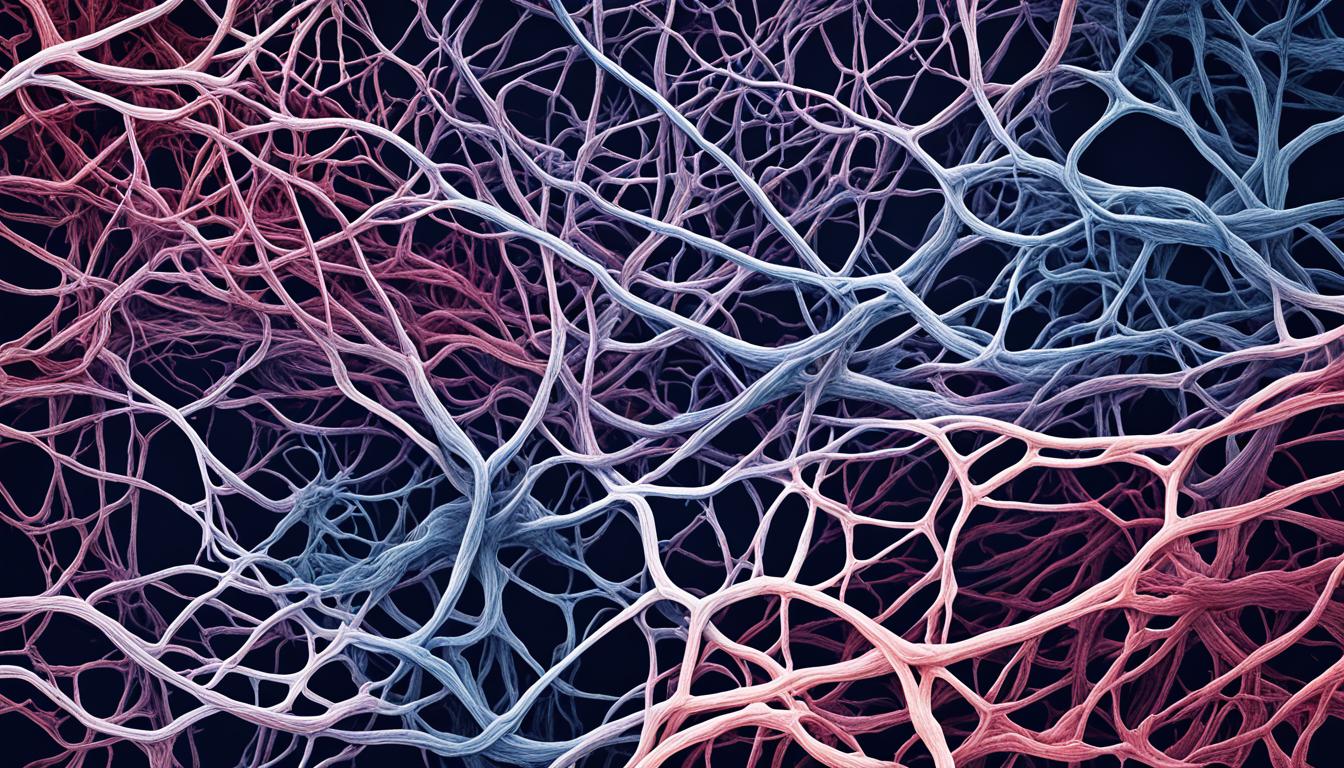Fibromuscular dysplasia (FMD) is a rare disease that affects the arteries’ walls. It changes them from being strong and flexible to stiff and weak. The exact cause is unknown, but genes and hormones likely play a role.
This condition impacts various arteries, notably those leading to the kidneys, neck, and brain. People with FMD might not show any signs, but some feel headaches, ringing sounds in the ears, or high blood pressure. It’s diagnosed through tests that show the artery’s condition.
While FMD has no cure, treatments help control symptoms and prevent issues like high blood pressure. Patients may need to take medicines, alter their lifestyle, and occasionally undergo surgeries to handle severe problems.
Stem cell therapy presents an exciting new approach for FMD. It explores using stem cells to help repair arteries and improve their function. More research is necessary to confirm its benefits and ensure its safety.
Key Takeaways:
- Fibromuscular dysplasia (FMD) is a rare vascular disease characterized by the replacement of strong, flexible arterial cells with fibrous tissue.
- FMD can lead to complications such as high blood pressure, stenosis, aneurysm, and artery dissection.
- Diagnosis of FMD is often made through angiography or other imaging tests.
- Treatment for FMD focuses on managing symptoms and preventing complications through medication, lifestyle changes, and medical procedures.
- Stem cell therapy is an emerging field that holds promise for the treatment of FMD, but more research is needed.
What is Fibromuscular Dysplasia?
Fibromuscular dysplasia (FMD) is a rare disease that affects the arteries. It happens when the strong and flexible cells in the arteries are replaced by fibrous tissue. Unlike some other diseases, like those from plaque or inflammation, FMD changes how the arteries are built.
Arteries have three layers: the tunica intima, tunica media, and tunica externa. The tunica intima is the inside layer that touches the blood. The tunica media is the thick, middle layer with muscle cells and elastic fibers. The last layer, tunica externa, is the outer coat made of elastic fibers and collagen.
FMD makes the arteries stiff and less flexibile because of the fibrous tissue. This can lead to problems like high blood pressure, stenosis, and aneurysm. Sometimes, the arteries might look like they have a “string of beads.” These issues can slow down blood flow and increase the chance of heart problems.
Dealing with FMD can be hard because it’s not common and shows up differently in people. Knowing about the arteries and how they change helps doctors diagnose and treat FMD. Next, we’ll look at the signs and tests for fibromuscular dysplasia.
Symptoms and Diagnosis of Fibromuscular Dysplasia
Fibromuscular dysplasia (FMD) is a disease of the blood vessels. It can have different symptoms, depending on the affected arteries. Some people with FMD don’t show any symptoms. Others may have problems that show which arteries are affected.
Fibromuscular dysplasia shows up in several ways. Some common symptoms are:
- Headache: FMD can cause chronic and severe headaches for some patients.
- Pulsatile tinnitus: A rhythmic sound in the ears, tied to the heartbeat, may be noticed by some.
- Neck pain: Neck pain might happen when the carotid artery is involved.
- Hypertension: High blood pressure can occur with FMD, and it might be tough to treat or come on suddenly.
Fibromuscular dysplasia can also link to other conditions. Such as:
- Resistant hypertension: Some FMD patients might not see their high blood pressure improve with treatment.
- Stroke or transient ischemic attack (TIA): The risk of these events can go up with FMD.
- Spontaneous coronary artery dissection (SCAD): FMD could lead to rare cases of coronary artery tears.
Diagnosis of FMD is not easy, as many with it may not know. Doctors use tests to confirm FMD. These include:
- Angiography: Doctors use this imaging test to see the affected arteries and find issues.
- Computed tomographic angiography (CTA): It’s a test that creates detailed images of blood vessels without surgery.
- Magnetic resonance angiography (MRA): This test uses a magnetic field and radio waves for detailed images.
- Duplex ultrasound: This non-invasive test uses sound waves to check blood vessels and blood flow.
Doctors might also listen for a certain sound, called a bruit, over affected arteries. Early diagnosis and regular imaging help manage FMD and avoid complications.
Treatment and Outlook for Fibromuscular Dysplasia
Fibromuscular dysplasia (FMD) requires careful management to avoid problems and keep a good outlook. It’s important to see doctors who know about this kind of vascular disease. Treatment over time includes taking certain medicines, having regular check-ups, and changing some habits.
Doctors might give you aspirin to stop blood from clotting and to handle FMD symptoms. You will also have imaging tests like CTA or MRA to check how your condition is doing.
Changing your lifestyle is key for dealing with FMD. It’s a must to stop smoking to save your arteries from more harm. Also, eating less salt and being active every day can help your heart stay healthy.
There’s hope in stem cell therapy as a new way to treat FMD. But, we still need more research to be sure it’s safe and works well. Remember, keeping up with treatments and seeing your doctor regularly is vital for staying healthy.

